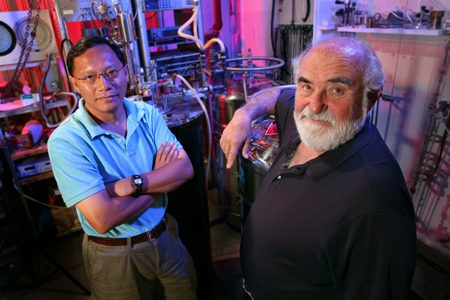
With a $450,000 grant from the National Science Foundation (NSF), a pair of Florida State University scientists are performing basic research involving electricity that could provide an important building block in the emerging technical field known as spintronics.
Stephan von Molnár and Peng Xiong, both professors of physics, will utilize the NSF funding to perform advanced measurements on semiconductors developed by colleagues in China. Their goal is to determine whether a basic property of electrons can be harnessed in such a way that future computers and other high-tech electronic devices would require far less power to run. Some believe this property, the spin, could even lead one day to the "Holy Grail" of information processing — so-called quantum computing.
"Electrons are one of the elementary particles of matter, meaning they can’t be broken up into still smaller particles," said von Molnár, the project leader on the NSF grant. "And as we all know, electrons produce an electrical charge. It is this electrical charge that we currently use to power everything from can openers to televisions to laptops.
"But what most laypeople probably aren’t aware of is that electrons also possess an intrinsic property known as ‘spin,’" von Molnár said. "It isn’t a perfect analogy, but picture a spinning top on a table. In the case of an electron, that spin generates a magnetic field, and the magnetic field can be manipulated in a way that has commercial applications."
Specifically, von Molnár said, magnetic electrodes can be applied to a semiconductor so that the electrons flowing through it will have a specific spin direction.
"It takes much less energy to flip an electron spin than taking an electron out of a transistor as in conventional electronics, meaning less energy is required to perform logic operations in spintronics," Xiong said. "So high-tech electrical devices such as computers and cell phones could be built that require far less electricity to operate than is currently needed. In addition, it would eliminate volatility in computer memory, meaning no information would be lost in a power outage and a computer could be turned on and off instantly."
And although still purely theoretical, many researchers also believe that electron spin can be controlled in a way that enables the electrons to carry, manipulate and store information, ushering in a technological revolution in the computing field. So-called quantum computers would harness this spin to perform memory and processing tasks on a scale far beyond those of current computers.
But before any such breakthroughs can occur, research such as that being conducted by von Molnár and Xiong must take place to provide a basic understanding of the properties of electron spin in solids. Using semiconductors "grown" by Chinese colleagues, they will perform detailed measurements to see how long electrons retain their spin orientation — essential information for designing spintronics devices.
Beyond the research itself, the NSF funding is significant for another reason: It is the first of the NSF’s Materials World Network grants to support a collaborative effort between American and Chinese researchers.
"The collaboration grew out of a discussion at the sideline of a spintronics conference with our collaborator at the Institute of Semiconductors, Chinese Academy of Sciences," Xiong said. "She was able to obtain a grant from her own funding organization, which is similar to the NSF. So we were able to form a partnership that utilizes the strengths of both institutions — theirs in the production of high-quality semiconductors and ours in the performance of complex device fabrication and spin-detection measurements."
An important aspect of the joint venture is the extraordinary opportunity it presents to Florida State physics graduate students working on the project, von Molnár said.
"We plan to establish an exchange program that will afford our students firsthand exposure to materials research in a premier Chinese institution," he said. "They will receive extensive experience in condensed-matter experimental techniques that they wouldn’t be able to get at most U.S. universities."
Von Molnár and Xiong’s NSF project is titled "Investigation of Coherent Spin Transport in the Persistent Photoconductor AlGaAs Using All-Electronic Spin Injection and Detection." In addition to the professors, doctoral student Jennifer Misuraca is playing a leading role in the project.




